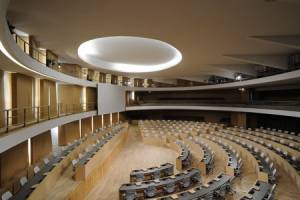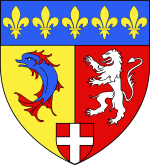User Tools
Stakeholders involved in La Verpillière station
Stakeholders construction
STATE
Regional and local authorities: A regional or local authority is a legal body which possesses certain legal powers conferred by the state through its decentralization plan. Local authorities are usually municipalities, administrative counties— “departements”—or regions.
1) The Rhône-Alpes Regional Council:
Rhône-Alpes is one of France's 22 administrative regions. At the institutional level, it has two assemblies, the Regional Council (Conseil Régional) and the Regional economic, social and environmental Council (Conseil Economique, social et environnemental régional), known as the CESER. The Regional Council is run by 157 regional councillors elected by direct universal suffrage for a four-year term (2010/2014). Its role is to deal with the Region's business during plenary assembly and standing committee meetings. The Regional Council's remit affects numerous aspects of its citizens' daily lives, including transport, high schools and colleges and even employment. The councillors elect a president who joins together with fifteen vice-presidents and nine appointed councillors, each of whom is responsible for a specific policy area (culture, international relations, etc.), to form the Executive.
The CESER is an Assembly composed of 122 members from the trade union, voluntary and economic sectors, which examines certain matters and delivers opinions to the Regional Council and its President. The President may also refer any issue connected with the Regional Council's remit to the CESER. The Regional Council's policies cover a wide range of fields. However, the Region's main responsibilities primarily concern:
• High schools and apprenticeship. The Rhône-Alpes Region funds the construction and maintenance of high schools across its territory, looks after their operating budgets and purchases educational materials such as IT and audio-visual tools. • Vocational training. Universal access to lasting employment is the Regional Council's number one objective. It funds further training courses for young people and adults, provides Rhône-Alpes citizens with support and assistance in their career and job changes and is developing the Accreditation of Prior Experiential Learning (APEL). • Regional public transport systems. The trains, buses and coaches that are so familiar to thousands of Rhône-Alpes inhabitants are funded by the Region, which also develops the region's railway stations, offers affordable fares to everyone and is increasing the frequency of services. • Economic development and employment. The aim of Rhône-Alpes is to make full use of every possible source of employment. For example, it supports business start-ups and redevelopments, the development of SMEs, and business units (clusters) focusing on core businesses of strategic importance to the regional economy (environment, food industry, etc.). • Spatial planning. The Region has acquired a comprehensive range of tools to help it work towards a balanced spatial development approach meeting its social improvement, economic efficiency and environmental protection objectives - in other words, a sustainable development approach. In 2004, a new phase of decentralisation (whereby the Government devolves responsibility to the Regions in certain fields) began. The Regional Council took over responsibility for high school technical and service staff, healthcare and social work training courses (nurses, social workers, etc.) and for the cultural heritage inventory department. The Regional Council is currently developing action in other fields, such as international aid, health, sport and renewable energies.
In March 2004, Jean-Jack Queyrannewas elected to the post of President of the Rhône-Alpes Regional Council by the regional councillors. He has been re-elected in March 2010 for 5 years.
In his capacity as President, he has a variety of duties: • he draws up and implements the Regional Council's decisions and rulings • he monitors regional income and expenditure • he signs orders and decrees, agreements and contracts, and is empowered to file lawsuits on behalf of the Regional Council • he leads the Regional Council's departments and appoints its officers - he manages the Region's assets. Short biography President of the Rhône-Alpes Regional Council since 2004, MP for the Rhône since 1981 (re-elected in 1986, 1988, 1997, 2002 and 2007) Jean-Jack QUEYRANNE is also a member of the Constitutional Acts, Legislation and General Administration Committee and of the National Assembly study group on Towns and Suburbs. He was Secretary of State for Overseas Territories from 1997 to 1998, acting Interior Minister in 1998, and then Minister of Parliamentary Relations from 2000 to 2002. Jean-Jack QUEYRANNE was Deputy Mayor of Villeurbanne from 1983 to 1988, Mayor of Bron from 1989 to 1997, and then Deputy Mayor from 1997 to 2004. He holds a PhD in Political Sciences and is a senior lecturer at Lumière-Lyon II University.
2) The Rhone “Departement” General Council
The president of Rhône General Council has been Danielle Chuzeville Rhône since 2013. The Rhone General Council is part of the Rhône-Alpes region.
Shield logo and the Rhône-Alpes Region:
3) The town of La Verpillière :
The commune of La Verpillière is located around the centre of the town of La Verpillière, which is situated to the east of Lyon, just off the A43 motorway that leads to the Alps. There has been heavy investment in the road infrastructure, especially the deviation of the highway RN6. Now the same needs to be done for the station which hosts around 2,000 passengers per day and which has seen the highest growth of any station in the whole of the Rhone-Alps region. La Verpillière is located approximately 20 minutes away from both the international airport and the railway station of Lyon Saint-Exupéry, and so it is part of a developing area that has become an international hub. The town of La Verpillière has around 6700 inhabitants, and there are many small shops that are finding life increasingly difficult as trade shifts to online purchase or multipurchasing at hypermarkets. As part of the North Isère valley corridor, La Verpillière also belongs to the conglomeration of towns called the “CAPI”. In the March 2014 elections, Patrick Margier was re-elected Mayor of La Verpillière with a large majority of town councillors (22 for his UMP majority against only 7 opposition councillors, 5 for the left-wing alliance and 1 centre-ground Modem party). The Deputy Mayor in charge of Business and Primary Education, a well as being a CAPI representative, is Pascale Sautarel-Bidard.
4) The town of Villefontaine:
In the March 2014 elections, Raymond Feyssaguet was also re-elected Mayor of Villefontaine with a sizeable majority of town councillors (25 for his centre-right majority against only 8 opposition councillors, 6 for the left-wing alliance and 2 for an independent group). The Deputy Mayor responsible for resources and means is Patrick Nicole-Williams. The town council also includes Carine Kopferschmitt, responsible for solidarity, Jean -Christophe Dura, responsible for planning and environment, Maryse Loriot Carnis, responsible for trade and economic development, and Michel Imbert, responsible for cultural development. According to the French bureau of national statistics, INSEE, the population of Villefontaine taken is 18 374 inhabitants, as of 1st January 2013.
5) RFF (Réseau Ferré de France or “France rail network”):
The rail network is owned by RFF. Réseau Ferré de France provides access to 30,000 km of lines across France – making the network dense, open and in line with the new mobility requirements of both passengers and freight. This includes: • traffic management; • increasing the attractiveness of the network; • sustainable funding; • developing new railway lines; • optimising property assets. It is up to this body to develop and maintain the line, as well as to manage the traffic schedules for the various operators.
Key private players:
1) Sainte-Marie Lyon School is located just to the north of the station and many teachers and students use the train line on a daily basis. Also the safety of students who pass by a level crossing is a major issue for all parties. Therefore the school leadership and also the Economic and Social Science students of the Comenius Project working on the station redesign are keenly interested in playing an active role in the development of the station and the land around it.
2) Nemera, a company specializing in the design and manufacture of drug delivery systems, has its headquarters in the North Isere plant at La Verpillière, which is sited just south of the train lines and opposite the current location of the SNCF station office. They hope to acquire part of the brownfield site south of the station for the future development of their activities.





